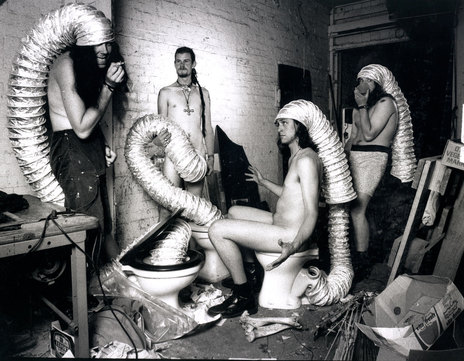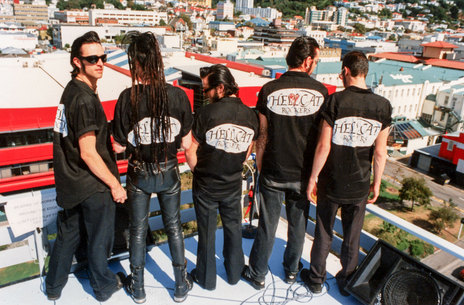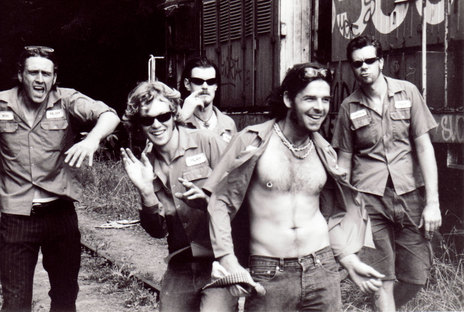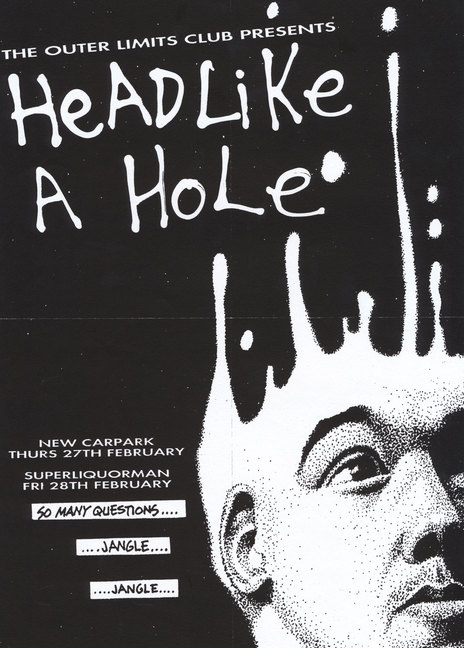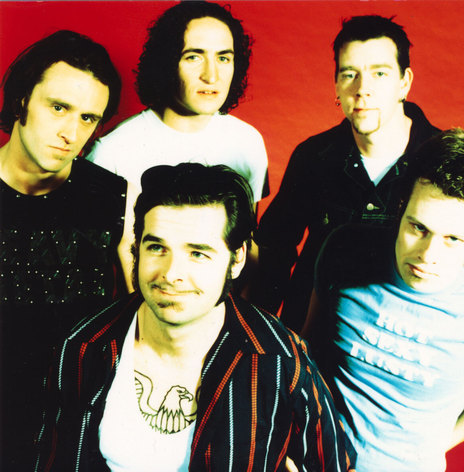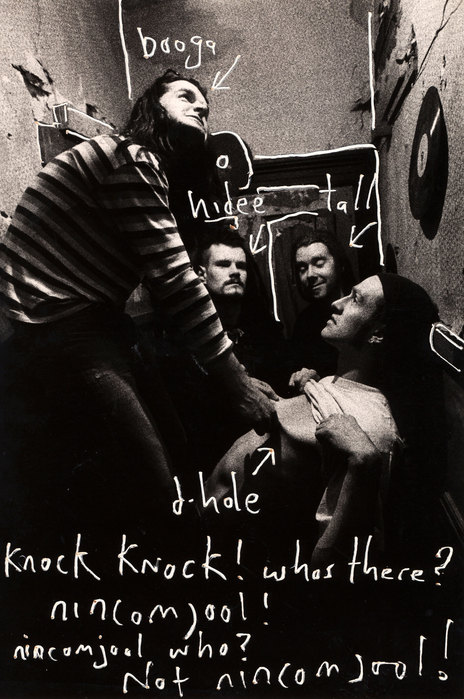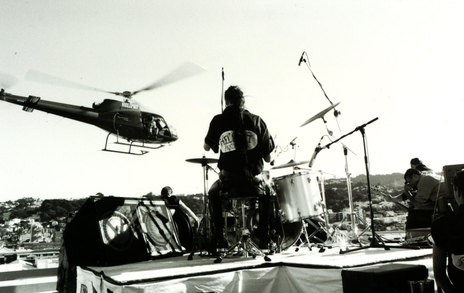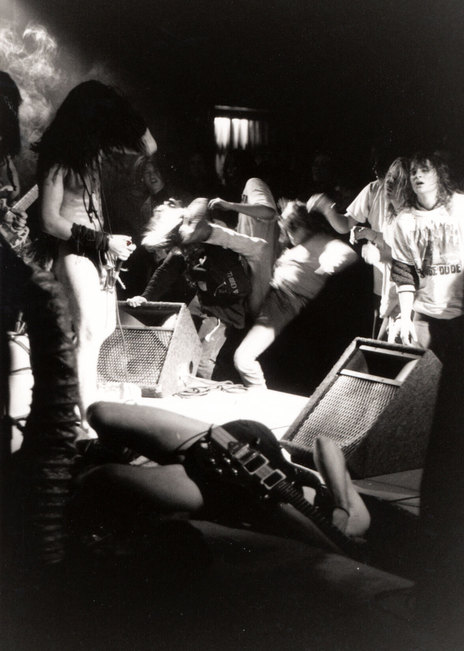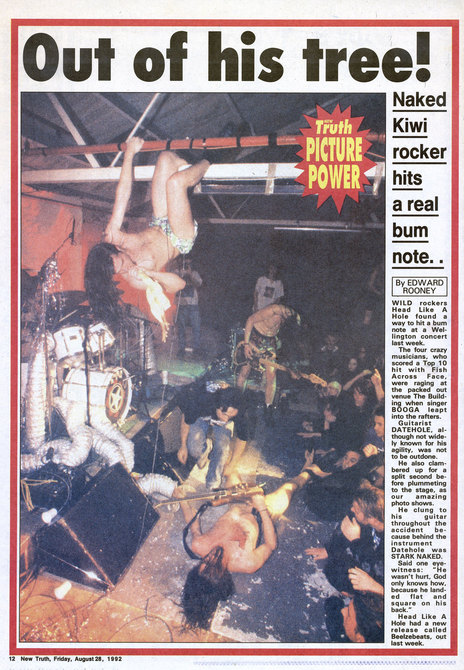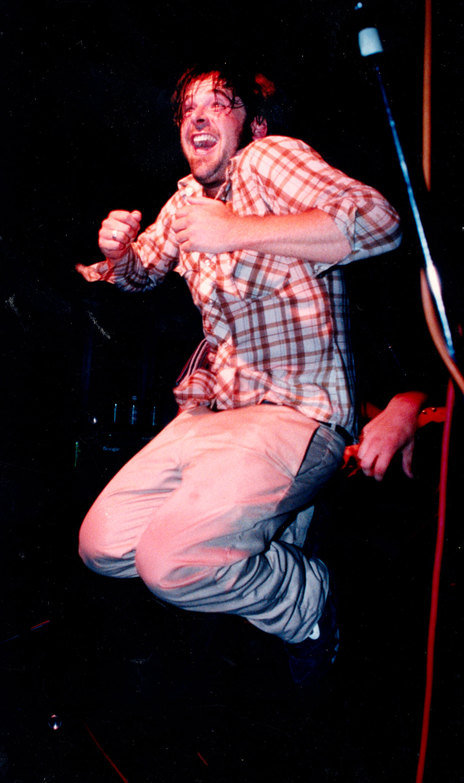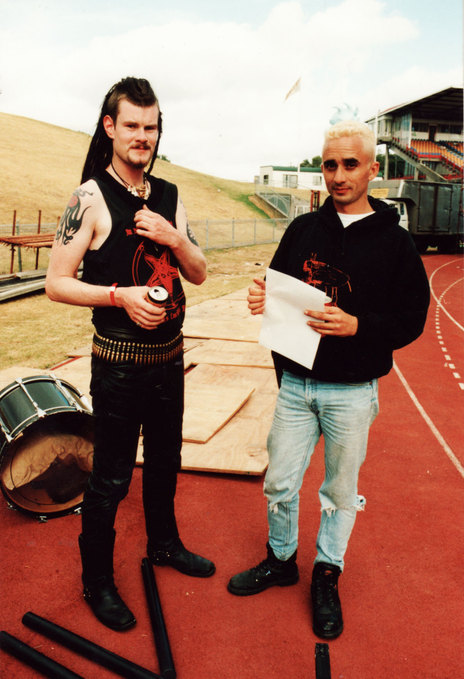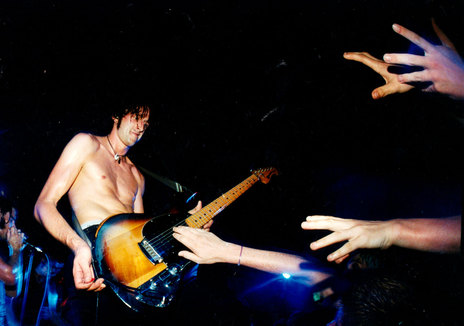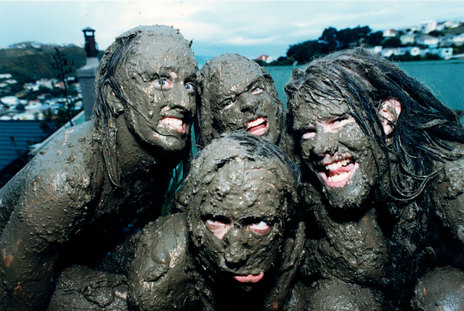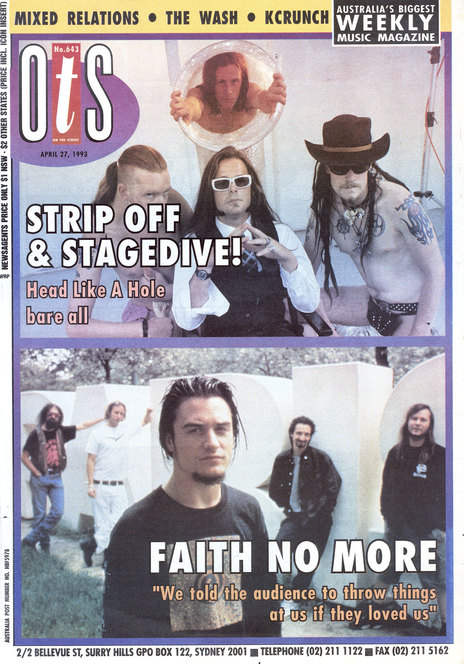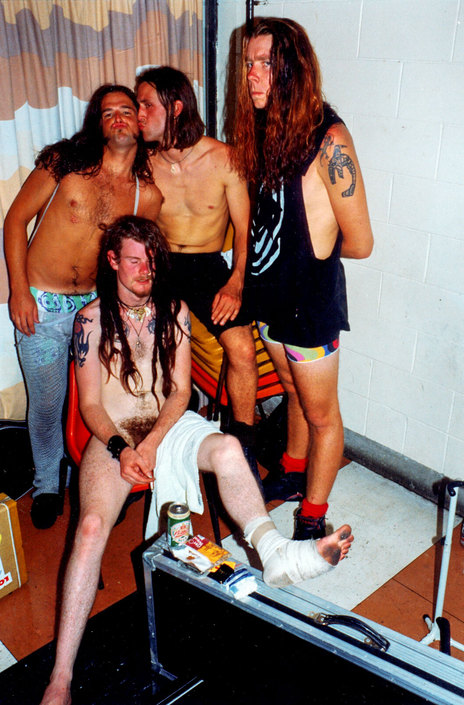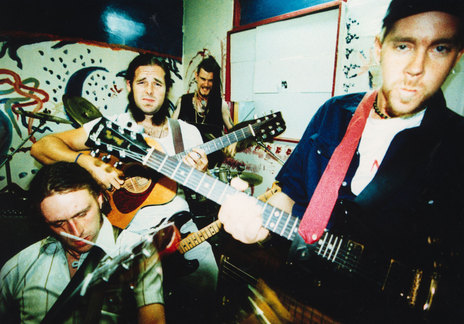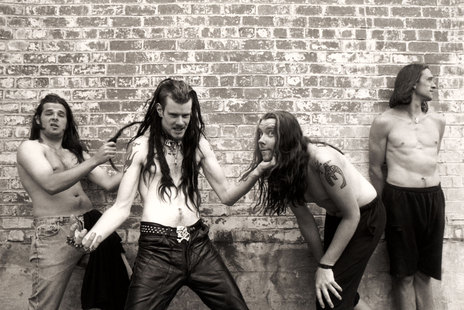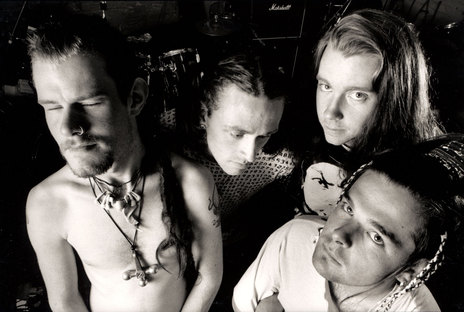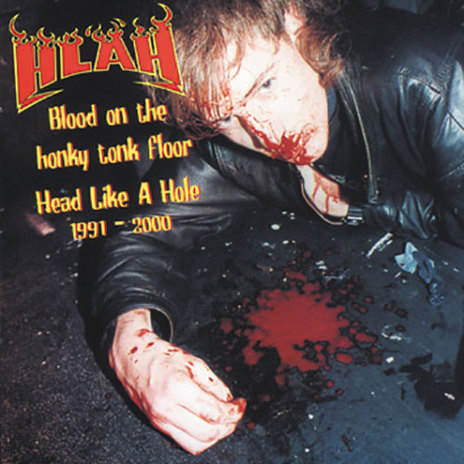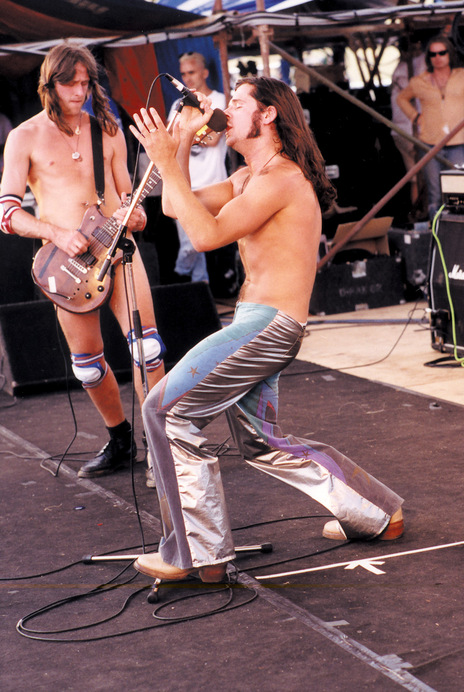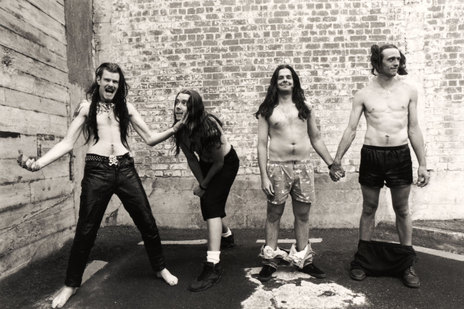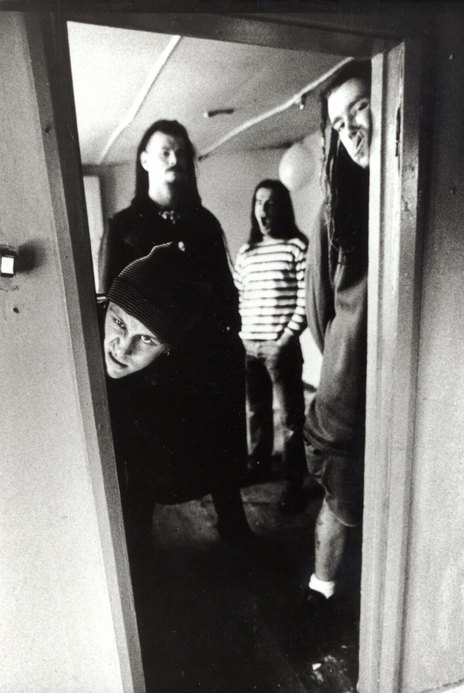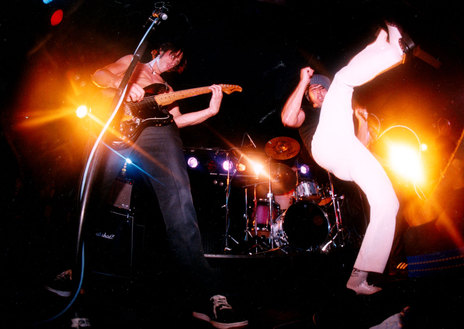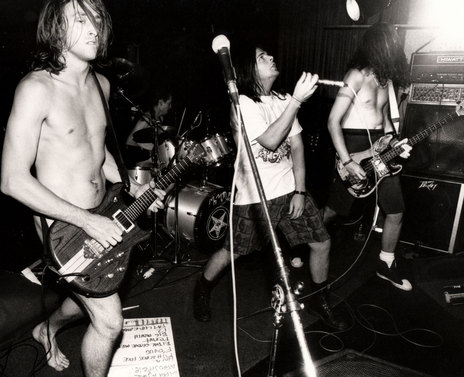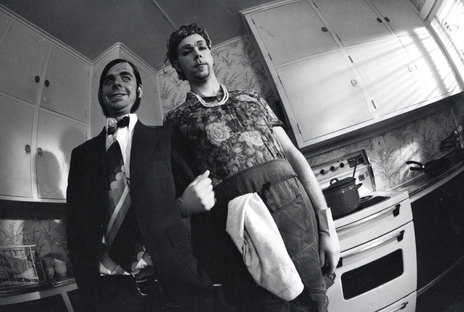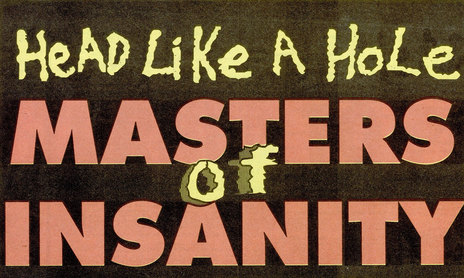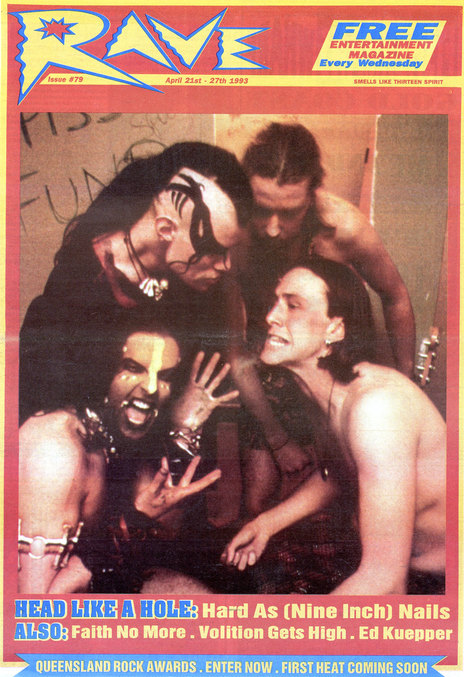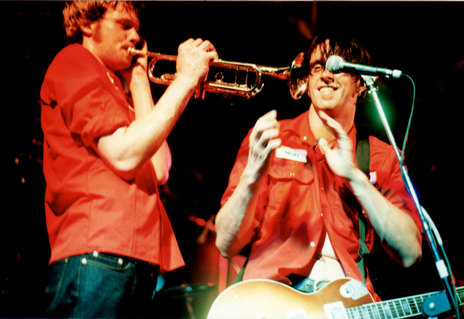“The crowd are convulsing, milking every scatological note and beat for all its reality twisting worth,” wrote a journalist from Australian metal magazine Hot Metal in 1994. “HLAH are about losing it ... so it won’t be found until three months later, covered with that mould that forms at the bottom of beer bottles.”
Head Like a Hole formed in Wellington towards the end of 1990. Vocalist Nigel “Booga” Beazley returned to the city from studying in Auckland, and met guitarist Nigel “Datehole” Regan and drummer Mark “Hidee Beast” Hamill, who’d begun playing together.
The trio started practising at the old Empire Spice warehouse on Hopper St, which they shared with Shihad. Soon bassist Andrew “Tallbeast” Durno came onboard, and the nascent HLAH performed their first show at the warehouse.
“We appeared out through this trapdoor under the stage,” Regan remembered, “and walked on and grabbed our guitars and went ‘one, two, three, four’ and shook the hats off and all our hair came flying out. It was a fucking good gig, and basically what inspired us to continue and carry on.”
HLAH’s first single was the grinding industrial metal of ‘Fish Across Face’, which went to No.9 on the NZ Singles Chart in 1992.
Within months they’d made their first recordings on an 8-track at the Empire warehouse. The result of this was the Shitnoise cassette, containing four songs that exhibited just what a potent force HLAH already was. ‘Head of Ignorance’, ‘Air’, ‘Never Mind Today’, and ‘Life’s a Joke’ overflowed with the amalgam of filthy humour, chaotic abandon, and tight funk-metal dynamics that marked the band’s early career. Shitnoise was sold in limited numbers on that first national tour with Shihad, which exposed HLAH to audiences in 10 New Zealand cities.
Exposed HLAH literally were, as unashamed nakedness became the calling card of their early career. Regan and Hamill routinely took the stage naked, the drummer supposedly being unable to play when clothed.
HLAH’s first single was the grinding industrial metal of ‘Fish Across Face’, which went to No.9 on the NZ Singles Chart in 1992. The video featured nakedness, mud-encrusted band members, tribal body paint, and no end of crazy antics. It caused some controversy; TVNZ banned the clip because of a section where Regan and Beazley exchanged a stream of orange juice mouth-to-mouth.
If they caused a small stir in New Zealand, HLAH’s first trip to Australia in April 1992 proved to be tabloid fodder. Glossy gutter press weekly People were naturally drawn to the spectacle, titling their expose "Dirty pluckers hit rock bottom", complete with a photo of the band covered in mud. The scatology-obsessed article catalogued HLAH’s nefarious extremes, care of band manager Gerald Dwyer. “Playing in the nude isn’t a gimmick,” Dwyer explained. “They played naked from the very start. They’re a pretty wild bunch.”
“Playing in the nude isn’t a gimmick,” Dwyer explained. “They played naked from the very start. They’re a pretty wild bunch.”
The Australian visit was in support of HLAH’s debut album, 13. Produced by the band and Brent McLaughlin at Skeptics’ Writhe Studio in Wellington, the album was released by Wildside Records in Australasia. For the rest of the world, it was released by German metal label Noise International, who Dwyer had arranged deals with for both Shihad and HLAH.
13 was a fine document of the early incarnation of the quartet. Along with more polished versions of Shitnoise tracks ‘Life’s a Joke’ and ‘Never Mind Today’ were instant classics like ‘Penut’, ‘Afro Surprise’, ‘12’, and unofficial manifesto ‘Narcotics, Noise, and Nakedness’. The album reached No.17 in the NZ Album Chart, and HLAH enjoyed large crowds around the country.
In 1993 Regan moved into 301 Willis St in Wellington, a two-storey wooden house with a lot of history. Early in the 20th Century it had been an illegal abortion clinic, and in the middle of the century the house was a hub for New Zealand’s artistic community. The likes of James K Baxter, Denis Glover, Douglas Lilburn, and Frank Sargeson had spent time there. Later it was an illegal distillery, "a den of iniquity and nest of Red student agitators" according to NZ Truth, and a punk hangout.
301 Willis St became an important part of the HLAH story, as it was there that Regan set up a 4-track home studio in what became known as the Stench Room. The studio allowed HLAH and associated acts the time and space to work on their material away from the pressures attached to commercial recording studios.
“At that place it was all about fun, and whoever was there and could play something generally did,” Regan says. “I did try and start running it as a semi-proper studio, and there must be quite a few recordings kicking around of all these Wellington bands of the time.”
Before anything from the Stench Room was released, HLAH launched the Beelzabeats EP in 1993, again recorded at by Brent McLaughlin at Writhe. Again featuring ‘Never Mind Today’, the EP also contained some of the band’s heaviest moments with ‘Regular Guy’, ‘Misery Guts’, and ‘Spitbag’.
March 1994 saw the release of HLAH’s second album, the cryptically titled Flik Y’Self Off Y’Self.
March 1994 saw the release of HLAH’s second album, the cryptically titled Flik Y’Self Off Y’Self. It was preceded by the Faster Hooves EP, containing the album’s first single, two further HLAH tracks, and demos from Wellington bands Funkmutha and Steak. Faster Hooves was a more hook-laden and accessible proposition than HLAH’s earlier material, and showed the way forward.
That was emphasised by their rollicking, groove-ridden next single, ‘Spanish Goat Dancer’ - perhaps the band’s most irresistible track to this point. On the back of a great video filmed at 301 Willis St, it reached No.14 on the NZ Singles Chart.
However, although there were some other standout moments on Flik Y’Self Off Y’Self, including ‘Chalkface’ and ‘1 Pound 2 Pound’, the majority of the album was impenetrable. This was largely thanks to a surplus of in-jokes, murky production, and a generally muddled aesthetic. While it reached No.13 on the NZ Album Chart, the album proved difficult to swallow for Noise Records in Germany, who were mystified as to how to market it to European metal audiences.
Funkmutha guitarist Tom Watson had moved into 301 Willis St, and soon became a permanent member of HLAH. In mid-1995 the now five-piece HLAH ventured on a three month, 50-date tour of Europe, supporting Shihad and playing their own shows.
They received mixed responses across the continent: from 5000 death metal fans at the Polish Metal Mania festival making throat-slitting gestures, to a reviewer for English metal magazine Kerrang! calling HLAH a “revelation”, while slating Shihad.
Despite some positive reactions, while in Europe the band parted ways with their uncomprehending European label. “(Noise) came and saw us play,” Regan said. “And they were asking us, ‘Where’s the body paint? Where’s the costume changes?’ We were like, ‘well, if you had seen us play three years ago ...’”
While staying above the Knaack Club in the old East Berlin, members of HLAH and Shihad recorded the Berlin Stench sessions on a 4-track recorder. It was later released in a cassette edition of just 100 copies.
Drugs had become a pervasive influence within HLAH, enhanced by easy access while in Berlin.
Back in New Zealand, the band toured the country in late 1995 while manager Dwyer tried to attract a new international record deal for them. Drugs had become a pervasive influence within HLAH, enhanced by easy access while in Berlin. Various members, and Dwyer, had more than dabbled with hard drugs. On the night of the 1996 Big Day Out in Auckland, after fine performances from HLAH and Shihad, Dwyer was found dead in his motel room.
The tragedy obviously took a personal toll on the band, and it also stalled their career plans. “After Gerald died it just got really hard,” Regan said. “We didn’t get any decent management and not having that was just a real struggle.”
Despite the massive setback, HLAH began work on their third album. The Stench Room studio had become a more serious endeavour, and was now home to an 8-track recorder. Shihad had written much of their third album there, while Regan and Shihad’s Jon Toogood had recorded their SML project there.
The quintet recorded demos for what would become the Double Your Strength, Improve Your Health and Lengthen Your Life album in the Stench Room. Although they ultimately recorded the album with co-producer Robbie Rowlands at Sing Sing Studio in Melbourne, the demos captured something special.
“I remember thinking that we could just go somewhere and mix it properly, instead of going and re-recording it for 40 grand,” Regan said. “Some of the versions of these songs were totally ripping and the sound was really good too.”
HLAH wowed the audience with a crafted set of energetic rock songs and a far more debonair appearance.
Double Your Strength, Improve Your Health and Lengthen Your Life was released in September 1996. The premiere show was at the James Cabaret in Wellington, and HLAH wowed the audience with a crafted set of energetic rock songs and a far more debonair appearance. It was quite a transformation, as the metal allusions and outrageous stage antics were abandoned. Instead, there were plenty of infectious and fun songs like ‘Cornbag’, ‘A Crying Shame’, and ‘Hootenanny’, complete with tinges of country rock.
“I think we lost the noise-for-noise-sake,” Regan reflected. “But it’s still basically the same three or four chunky power chords. [Watson] described it as AC/DC meets The Bee Gees. Songs like ‘A Lot of Fun’ and ‘Keith’ are really what Head Like a Hole’s about: those big, solid grooves.”
Their third album was a stylistic triumph for HLAH, underlined by a compelling performance in the Supertop, as the last act of the 1997 Auckland Big Day Out. But internally things weren’t so great, as drug problems stopped the band from being a functional outfit.
This came to a head in early 1997, when drummer Hamill departed under a cloud to concentrate on his black metal project Demoniac. Michael Franklin-Browne replaced Hamill, whose HLAH swansong was the video for the band’s rockabilly-influenced cover of Bruce Springsteen’s ‘I’m On Fire’. An elaborate video was shot on a rooftop in downtown Wellington, complete with helicopters and a large street-level crowd. However, now based in Auckland, HLAH had lost the momentum of their first five years, and excepting some national tours and big support slots they were mostly quiet.
Recorded at Revolver Studio, HLAH IV: Are You Gonna Kiss It Or Shoot It? was released in late 1998. With singles including ‘Wet Rubber’, ‘Juicy Lucy’, and ‘Comfortably Shagged’, it was a collection saturated in rock and roll sleaze. But it was also another step forward, as synthesisers and samples were brought in to flesh out the songs, while Franklin-Browne and Watson’s contributions were strongly felt.
HLAH IV reached No.25 in the NZ Album Chart – eight places higher than the third album. But under the shadow of continued drug use, HLAH had become dysfunctional. The strain eventually told, and they played their last show at the Papakura Roadhouse in early 2000.
“Half a band on drugs and half a band not on drugs – it was just banging your head against a wall,” Durno later said. “It needed to end when it did. It could have ended a year earlier, but none of us wanted to give it up.”
It was no huge surprise when rumours of a reunion emerged in 2008.
Later in 2000 the Blood on the Honky Tonk Floor compilation was released. Although it was a fine collection of their best material, a bitter feeling remained about the manner in which HLAH had fizzled, having shown so much promise.
So it was no huge surprise when rumours of a reunion emerged in 2008. This came to fruition, and Beazley, Regan, Durno, Watson, and Franklin-Browne performed at the 2009 Homegrown Festival in Wellington.
Since then they’ve released another best-of collection and a new album Blood Will Out in 2011, which attained their highest chart place at No.8. “I feel as if I’m still young and I’ve got a lot to offer,” Beazley reflected before the release of HLAH’s fifth album. “I just hope that this time around people appreciate what we’re doing a little bit more.”
In 2017 Swagger of Thieves, a feature-length documentary about Head Like a Hole, was released. NZ On Screen wrote, “This all-access passion project from director Julian Boshier was a decade in the making, tagging along with Nigel 'Booga' Beazley (and partner Tamzin), Nigel Regan et al, as the still rocking members of this distinctive Kiwi rock’n’roll family enter middle age: spats, moshing n’all.”
